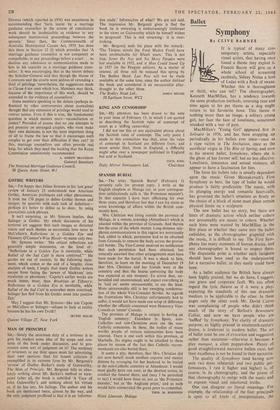Ballet
Symphony
By CLIVE BARNES
IT is typical of many con- temporary artists, especially visual artists, that having once found a theme they exploit it. Francis Bacon will give us a whole school of screaming
cardinals, Sidney Nolan a host
of Ledas with a flock of swans.
Whether this is thoroughness or thrift, who can tell? The choreographer, Kenneth MacMillan, has a tendency towards the same production methods, returning time and time again to his pet theme as a dog might return to his favourite bone. This theme is nothing more than an image, a solitary young girl, her face the face of loneliness, sometimes streaked with a tear of pain.
MacMillan's 'Young Girl' appeared first in Solitaire in 1956, and has been cropping up periodically in his ballets ever since—once as a rape victim in The Invitation, once as the sacrificial virgin in The Rite of Spring, and now in his newest ballet, Symphony, where she is the ghost of her former self, but no less effective. Loneliness, innocence and sexual violence, all appear to have a fascination for him.
The form his ballets take is usually dependent upon the music. Given Shostakovich's First Symphony as here, the type of ballet he would produce is fairly predictable. The music, with its plunging energy and romantic heart-calls, has governed the ballet's structure as firmly as the choice of a block of stone must place certain physical limits on a sculpture.
The new ballet has no story, but there are hints of dramatic action which neither cohere nor presumably are meant to cohere. Whether such hints were wanted by MacMillan in the first place or whether they came into the ballet unbidden, as the choreographer grappled with the music, it is difficult to say. The First Sym- phony has many moments of human drama, and any choreographer is bound to respect them. The disputable point is whether such incidents should have been used as the underpinning for a narrative ballet, as they easily could have been.
As a ballet audience the British have always been highly praised, but we do have, I suggest, one grave and corporate fault. We too often regard the lyric theatre as if it were a play, expecting the standards of this one dramatic medium to be applicable to the other. In these pages only the other week Mr. David Cairns was complaining of people who didn't think much of the story of Berlioz's Benvenuto Cellini, and now we have people who are 'baffled' by Symphony. Yet clarity of dramatic purpose, so highly praised in nineteenth-century drama, is irrelevant to modern ballet. The art of ballet must be one of evocation and suggestion rather than statement—otherwise it becomes a play manqué, a silent puppet-show. Plenty of good straightforward narrative ballets exist, but their excellence is not be found in their narrative.
The quality of Symphony (and having now seen two dress rehearsals and two public per- formances, I rate it higher and higher) is, of course, in its choreography, and the power of that choreography to merge with the music and to express visual and emotional truths.
One can disagree on literal meanings. For example, the relationship of the four principals is open to all kinds of interpretations, the validity of which must be in the eye of the observer. Yet this, even if baffling, does not matter as long as the general impression of desolation, loneliness and violence is conveyed. Unfortunately the general impression can easily be lost in searching for direct narrative links.
In an earlier ballet, Diversions, MacMillan established a freewheeling, fluid choreographic style, which he has further developed in Symphony. Here the pulse of the ballet is more varied, and huge, turbulent masses of dancers, groups of them spinning and leaping like unruly fireballs, are contrasted with passages of quiet melancholy and understated heroics. The choreo- graphic patterns shift and turn almost ex- plosively, with a sudden unexpected vigour. The originality of the dancing is always under- stressed, and even its feverish bouts of virtuosity are given a casual air. Beneath this seemingly wayward structure is an iron skeleton of crafts- manship.
The costumes of Yolanda Sonnabend are un- distinguished, perhaps more in their execution Than their design, and at first glance her red- brown cavernous setting dominated by what look like anatomical shapes—at times the work seems to take place in the belly of a whale— seems with its energy to detract from the equally rumbustious ballet. But the dancing, particularly that of the tenderly bewildered Antoinette Sibley, has the flash and polish of tempered steel. It is a fine ballet, but not one to approach with preconceptions. This is Shostakovich you are watching, not Chekhov.



































 Previous page
Previous page